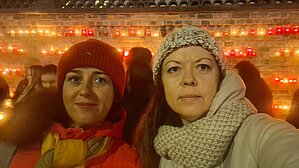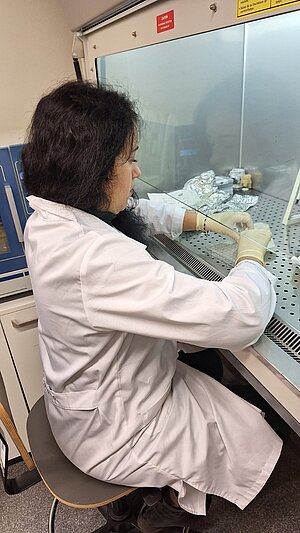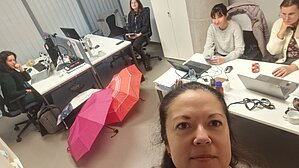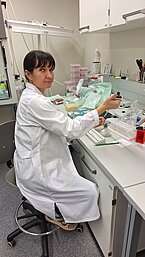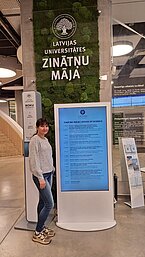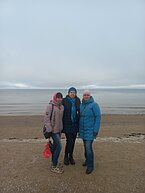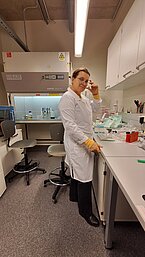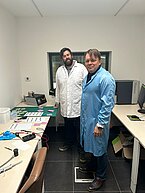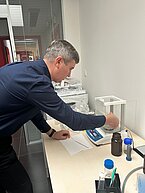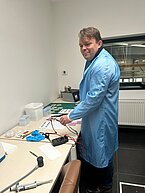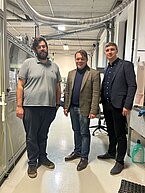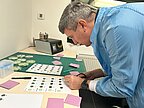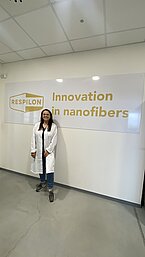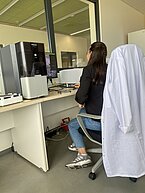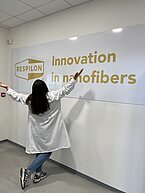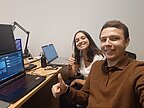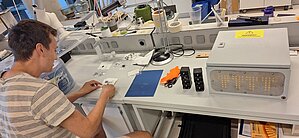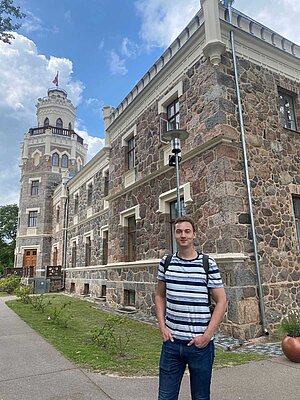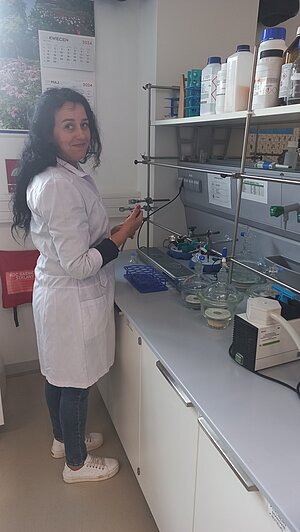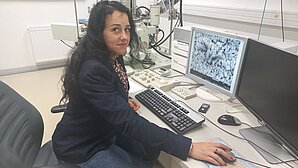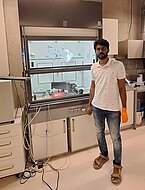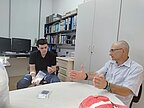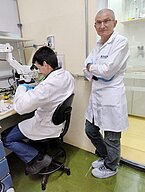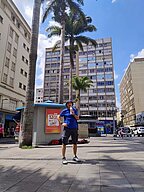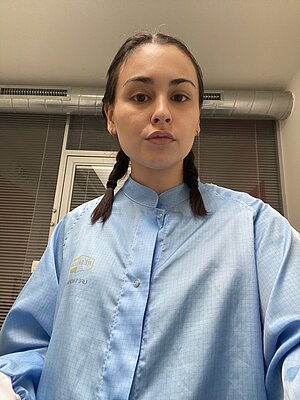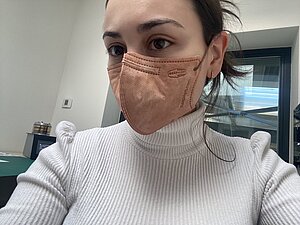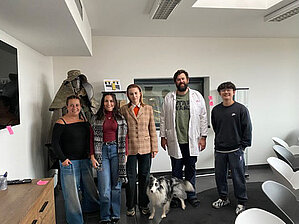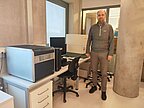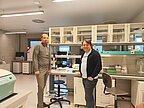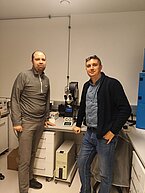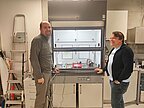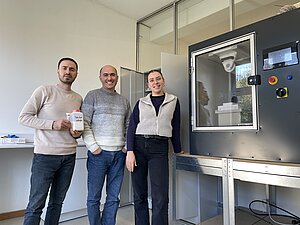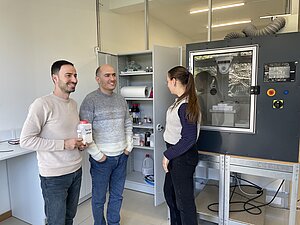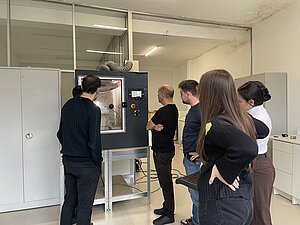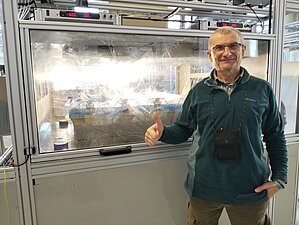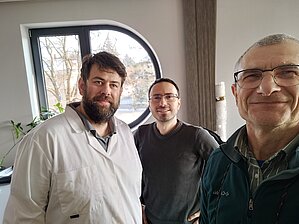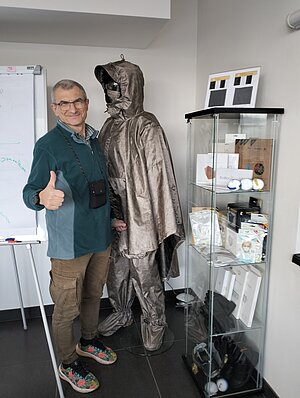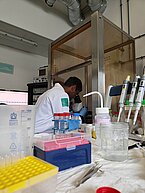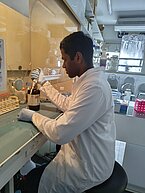During her secondment at INSERM from 2nd September 2024 to 21st December 2024, Maria João Ferreira from Biofabics gained invaluable experience in human induced pluripotent stem cell (hiPSC) culture and differentiation. The visit allowed her to delve into 2D and 3D differentiation protocols, focusing on the generation of hiPSC-derived cardiomyocytes.
Maria João was introduced to the 2D differentiation process, where she worked on establishing protocols for differentiating hiPSCs into functional cardiomyocytes. Additionally, she developed 3D cardiac organoids by applying a specialized differentiation protocol designed for 3D culture conditions, which is an essential model for more accurate cardiac tissue engineering.
One of the most impactful aspects of her visit was the exposure to electrophysiology techniques, particularly Microelectrode Array (MEA) recordings. These techniques allowed her to study the electrical activity of hiPSC-derived cardiomyocytes and organoids, providing a deeper understanding of cardiac cell function.
The interdisciplinary nature of the team at INSERM allowed Maria João to work alongside experts from various fields, broadening her scientific knowledge and expanding her skills. She had the opportunity to explore a wide range of methodologies and research topics, which enriched her overall experience.
During the visit Yevheniia Husak, significant progress was achieved in advancing the alcohol-assisted deposition method for integrating MXene into PCL electrospun membranes.
These results are especially critical for regenerative medicine, where reliable and biocompatible scaffolds are essential for success. The MXene-modified PCL membranes developed during this visit are well-aligned with the needs of conductive tissue engineering, particularly in challenging applications such as cardiac and neural regeneration.
Building on these achievements, future efforts will focus on evaluating the performance of the MXene-modified PCL membranes in biological systems through in-vitro and in-vivo testing. This will provide critical insights into their potential for clinical use. Furthermore, optimization of the alcohol-based solution composition will be explored to enhance deposition efficiency and ensure the long-term stability of the modified membranes. These steps aim to refine the technology and expand its applications in tissue engineering and regenerative medicine.
During a two-month secondment Viktoriia Kazban at the University of Latvia, solution parameters such as solvent types, concentrations, and electrospinning conditions were optimized to develop polymer solutions from polycaprolactone (PCL), polylactic acid (PLA), and chitosan for producing 3D electrospun membranes. Using conventional, multi-needle, and coaxial electrospinning, the desired membrane properties were achieved through precise parameter adjustments.
After extensive experiments, 3D electrospun PCL membranes with the required properties were prepared for MXene-related tests. Optimization of other polymers is ongoing and will continue in the next project phase.
This work aims to develop solutions for tissue engineering, cardiac and nerve regeneration, iPSC research, and wearable electronics.
From November 1th to November 30th, 2024, Viktoriia Holubnycha from SSU (Sumy, Ukraine) visited LU (Riga, Latvia).
In the frame of the secondment period, substantial progress was achieved in the development of porous 3D electrospun membranes using a variety of polymers and polymer blends, including PCL, PLA, and chitosan. Efforts were focused on optimizing the electrospinning process to produce membranes with precisely controlled porosity and enhanced structural integrity, making them suitable for advanced biomedical and technological applications. These studies aim to bridge the fields of materials science, regenerative medicine, and wearable technology, contributing to the development of next-generation biomedical devices and therapies.
From November 12 to November 26, 2024, Dr. Maksym Pogorielov and From November 11 to November 25, 2024 Dr. Volodymyr Deineka visited RESPILON MEMBRANES S.R.O., Prague, Chech Republic.
This visit aimed to study the features of industrial electrospinning and work with two independent high-voltage sources.The production of fibers with incorporated Mexenes nanolaminates was studied. Several working solutions of biopolymers with different concentrations of Mexenes were studied, and work was carried out to adapt the electrospinning modes. During the implementation, Dr. Deineka underwent intensive training in preparing and characterizing polymer solutions for electrospinning, as well as the effect of viscosity and electroconductivity of the solution on its ability to electrospinning. Dr. Pogorielov studied the dependence of changes in membrane electrical conductivity on the concentration of MXenes. The employees of RESPILON MEMBRANES S.R.O. demonstrated the best practices in manufacturing a clean line to produce electrospun membranes. Dr. Pogorielov shared the features of working with MXenes and their storage. The obtained PCL-MXene membranes will be studied for cytotoxicity and biodegradation. The obtained data will be used to prepare a joint publication upon completing all studies.
Mykola Pavlenko
Andriy Lys
Alexander Tamashevski
Oleksandr Solodovnyk
Viktorija Liustrovaite from Vilnius University (Lithuania) visited RESPILON in Czechia from September 8, 2024, to October 7, 2024.
During her secondment, Viktorija received hands-on training in preparing MXene solutions and depositing them onto nanofibers. She was trained in electrospinning techniques, focusing on the fabrication of PCL nanofibers and the optimization of processing parameters. Additionally, she gained experience in using SEM to characterize the morphology and surface structure of the coated nanofibers.
From 16th September to 15th November 2024, the secondee, Marina Sapauskiene, visited Respilon for a two-month secondment.
The main goal of the secondment was the preparation and characterization of MXene-coated nanofibers using electrospinning and direct-coating techniques. During this time, various concentrations of ethanolic and aqueous MXene solutions were prepared to optimize coating processes. The characterization of MXene-coated nanofibers was performed using scanning electron microscopy (SEM) and voltage testing. These methods allowed for the evaluation of morphological properties and the effectiveness of MXene deposition on nanofiber surfaces.
Regular training sessions were held during the secondment, providing expertise in the preparation of MXene solutions and nanofiber coating methods. The secondee also received hands-on training in electrospinning, covering all steps from polymer solution preparation to fiber production. In addition, detailed instruction on SEM techniques, including sample preparation and image acquisition, was provided.
Future research will focus on improving nanofiber coating techniques by developing multilayered coatings to enhance material properties. The long-term stability of the coated nanofibers will be evaluated, including durability tests under repeated washing cycles. Efforts will also be directed towards producing biocompatible nanofibers coated with MXenes for applications in fields requiring biocompatibility."
The secondment began with Ines Marques attendance at the IEEE NAP 2024 Conference, held in Riga from September 8 to 13. This conference brought together leading experts in nanomaterials and their applications, offering valuable insights into cutting-edge research and providing opportunities to establish professional connections within the field.
At the University of Latvia, the main experiment conducted aimed to evaluate how MXenes influenced the expression of specific genes in different cell types exposed to varying concentrations of these materials. In addition, she took the opportunity to deepen her understanding of the electrospinning technique, which will be essential for future projects.
Beyond laboratory work, she attended seminars and participated in team-building activities, which provided important insights and opportunities to connect meaningfully with colleagues.
This secondment was a rewarding experience that enabled her to develop her research skills, contribute to innovative projects, and achieve personal and professional growth in an inspiring environment.
Vipin Kumar Veeramuthu
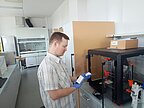
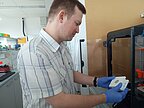
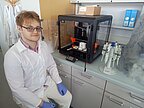
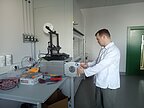
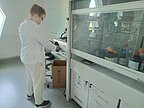
Dr. Mykola Pavlenko and PhD student Andrii Lys from AMU (Poznan, Poland) visited VU (Vilnius, Lithuania) from August 5th to September 4th, 2024.
During the visit in the frame of the Horizon Europe MSCA-SE project “Electro-conductive Polymeric 3D Scaffolds as Novel Strategies for Biomedical Applications” (ESCULAPE), Dr. Mykola Pavlenko and PhD student Andrii Lys received scientific training in the synthesis of noble metal nanoparticles and conducting polymer layers. Deposition of MXene-based electrodes for subsequent electrochemical analysis involved the preparation and optimization of MXene-based electrodes to ensure their effectiveness and stability across various applications.
Aleksi Kuivisto from the University of Eastern Finland (Itä-Suomen yliopisto) visited the Institute of Electronics and Computer Science (EDI) from July 1st, 2024, to July 30th, 2024.
During a one-month visit in the frame of the Horizon Europe MSCA-SE project, “Electro-conductive Polymeric 3D Scaffolds as Novel Strategies for Biomedical Applications” (ESCULAPE), measurement of the electrical conductivities of MXene-based electrospun scaffolds was carried out. As the first step, experiments to study the electrical conductivity development of MXenes after dip coatings. Here, the technique developed in UEF, Electrical impedance tomography (EIT), was used in EDI to overcome preliminary tests conductivity evaluation challenges based on MXenes inhomogeneous after scaffold coating.
From June 9th to August 8th, 2024, PhD student Katazyna Blazevic visited Uniwersytet im. Adama Mickiewicza w Poznaniu.
The purpose of the secondment was the development and optimization of MXenes nanocomposites using various coating techniques, followed by optical and electrochemical characterization.
During the secondment, Katazyna Blazevic learned about layer formation by spray coating technique for MXenes and the MXene-TiO2 composite. To assess the deposition of nanocomposite layers on the surface, the photoelectric characteristics of these layers were examined. The characterization of the produced layers was performed by employing photoelectrochemical, optical, SEM, and EDX techniques.
Optimal conditions for layer formation by the spray coating technique were determined and achieved. Promising results were obtained, showing a substantial increase in photocatalytic activity compared to pure TiO2 nanowires.
In future works, MXene nanocomposite deposition by spray coating technique can be used to deposit such nanocomposites on the polymeric membranes.
From 22 April to 21 May 2024, Ph.D. student Yevheniia Husak visited the THE ADAM MICKIEWICZ UNIVERSITY, Poznan, Poland.
During my visit, I conducted a series of comprehensive training sessions focused on laboratory safety protocols. The primary objective of this visit was to develop electro-conductive polymeric 3D scaffolds. My involvement included several key activities. Firstly, I meticulously prepared the PCL electrospun membranes with incorporated MXene at different concentrations to assess its impact on the scaffolds' conductive properties. Subsequently, I engaged in detailed morphological testing of the resultant membranes using a scanning electron microscope (SEM). This analysis was crucial to evaluate the surface structure, uniformity of MXene attachment, and the depth of MXene penetration within the membranes. Following the SEM analysis, I conducted further characterization of the membranes using Fourier-transform infrared spectroscopy (FTIR) and Raman spectroscopy. These techniques were essential to understand the chemical interactions and structural integrity of the MXene-loaded membranes. FTIR provided insights into the functional groups present and any chemical modifications, while Raman spectroscopy offered detailed information about the molecular vibrations and crystallinity of the materials.
Through these meticulous processes, we aimed to develop high-performance, electro-conductive polymeric 3D scaffolds with potential applications in tissue engineering and other biomedical fields. The comprehensive testing and characterization ensured that the scaffolds met the desired specifications and performance criteria.
The visit was carried out on research project Horizon Europe MSCA-SE project “Electro-conductive polymeric 3D scaffolds as novel strategies for biomedical applications”.
Anton Popov visited the NanoBioMedical Center, AMU (Poznan, Poland) from June 9, 2024 to July 8, 2024.
During the secondment, work on the synthesis and characterization of MXenes Ti3C2Tx was carried out. In addition, the deposition of MXenes by different methods on the electrode surface was studied. Electrochemical measurements were used to investigate the electrodes modified with the Ti3C2Tx MXenes layer. The optimal deposition parameters of MXenes layers were selected.
Dr. Anton Popov imparted knowledge on the synthesis and characterization of MXenes. Intensive training on spray coating techniques for the deposition of MXenes layer on different surfaces was carried out. The results obtained will be useful for the future deposition of MXenes on polymer membranes.
From 8 April to 7 August 2024 Vipin Kumar Veeramuthu visited University of Latvia.
During a four-month secondment at the University of Latvia, the assembly and commissioning of an electrospinning unit was successfully completed. This included the integration of key components such as pumps and collectors, all of which were sourced directly from LINARI ENGINEERING SRL, Italy. Rigorous testing ensured that the system operated seamlessly and achieved optimum performance.
This was followed by the selection of specific solution parameters, including solvent types, concentrations and nanofiber electrospinning processing conditions. These parameters were carefully selected to develop polymer solutions using polycaprolactone (PCL), polylactic acid (PLA) and chitosan tailored for the production of 3D electrospun membranes. Using conventional, multi-needle and coaxial electrospinning techniques, the desired membrane morphology and properties were achieved through careful manipulation of solution parameters and electrospinning conditions.
Finally, after numerous experiments and analyses, the 3D electrospun PCL membranes with the desired properties were prepared and can be used for experiments with MXenes. Other polymers were still being optimized to obtain perfect membranes and this will be continued in the next period of secondment.



Prof. Aku Seppänen from the University of Eastern Finland (UEF, Finland) visited the Institute of Electronics and Computer Science (EDI, Latvia) from May 1st, 2024 to May 15th, 2024.
The visit in the frame of the Horizon Europe MSCA-SE project “Electro-conductive Polymeric 3D Scaffolds as Novel Strategies for Biomedical Applications” (ESCULAPE) was devoted to MXenes testing including monitoring of MXenes conductivities in varying humidity conditions, effect of materials used in MXenes to its conductivity (e.g. use of Niobium (Nb) or Vanadium (V) instead of Titanium), the effect of Ti flake size in the solution to the MXenes conductivity and monitoring of the MXenes degradation process.
From 11 to 25 April 2024 Dr. Volodymyr Deineka visited the Vilniaus universitetas, Vilnius, Lithuania.
The visit aimed to conduct a structural description of the Ti3C2 and Nb2C Mxenes. Data between these two types of MXenes will be compared, and patterns of characteristics associated with the size of nanoparticles will be determined. During the implementation, Dr. Deineka received intensive training on working with SEM. The Vilniaus universitetas staff demonstrated best practices in studying nanomaterials.
After obtaining the structural characterisation results, the data were discussed to select the best samples to be coupled to the nanofibrous 3D membranes. Dr. Deineka demonstrated different types of polymer membranes obtained by electrospinning and spoke about the features of producing these materials. As a result of the discussion, the optimal parameters of the membrane were selected as a scaffold for applying Mexene.
The results of the visiting studies will be used in further studies of polymer-MXene membranes on experimental models in vitro.
From 21 February to 20 April 2024, Dr. Sergiy Kyrylenko from the Sumy State University conducted a research secondment to Universidade Estadual de Campinas (Unicamp). During the secondment, the electro-conductive polycaprolactone (PCL) electrospun nanofibrous membranes with Ti3C2 MXene surface layers, produced by the Sumy State University in collaboration with Materials Research Centre – MRC, were first tested in the conditions in-vivo to support neuronal regeneration in animal model of sciatic nerve injury in rats. To obtain more reliable and reproducible results, the similar membranes were produced also at the University of Latvia in Riga, Latvia.
At the Unicamp, together with Prof. Alexandre Oliveira and his team, a series of experiments were conducted to investigate how neuronal conduits, made out of MXene covered PCL nanofibrous membranes, could be used in design of neuronal conduits to support regeneration of sciatic nerves in the animal model of neuronal injury in rats. For this, the sciatic nerve was dissected and sutured by neurorrhaphy in conjunction with axon fusion technique. Functional recovery was monitored by CatWalk system during 4 weeks post operation. After that, the neuronal fibers together with the conduits and surrounding tissues were examined and prepared for transmission electron microscopy (TEM) investigations.
As a result, while the data processing is still in progress, it was showed that the functional regeneration occurred much faster than after the traditional neurorrhaphy. Importantly, it was also observed that the new conduits did not induce adverse accumulation of connective tissues at the site of treatment. Currently, experiments are in progress to show the microstructure of the axonal fusion and the state of the MXenes and the PCL nanofibers after 4 weeks in the animal’s body. In addition, currently a second series of experiments are planned to investigate functional recovery during 8 weeks post operation, as well as histological examination of the treatment sites.
From 25 November to 8 January 2024 Dr. Sergiy Kyrylenko visited Department of Technical Physics, University of Eastern Finland in Kuopio (Itä-Suomen yliopisto), Finland.
The visit started with intensive exchange of knowledge in the truly interdisciplinary fields. The objective of the visit was to evaluate if the technique of electric impedance tomography could be applied to study conductivity of the polymer-MXene membranes. As a result, the experimental setup was brainstormed and the design of the experiment was put together. To the best of our knowledge, that was the first approach to evaluate the spatial distribution of the conductivity of the polymer-MXene membranes.
Despite the extreme winter weather conditions, the visit was a complete success. During the visit the secondee received training in non-destructive electrical imaging techniques, while the host Department obtained new directions in working with MXenes and other nanoparticles. The research results of the visit will be utilised in the further investigations of the polymer-MXene membranes in the in-vivo experimental models.
Maria João Ferreira
Oleksiy Gogotsi
Veronika Zahorodna
Oleksiy Gogotsi
Veronika Zahorodna
Ivan Baginskiy
Serhii Dukhnovskyi
Oleksiy Gogotsi
Veronika Zahorodna
During this secondment Beatriz Carneiro, the study explored MXene coating on various nanofibers, assessing stability, retention of properties, and washing effects, with a focus on conductivity. Activities included sample centrifugation, solvent purification, vacuum-assisted MXene coating on Respilon nanofibers, and ethanol washing. SEM and conductivity measurements were used for evaluation.
Results showed uniform MXene coating by visual inspection, though precision could improve with specialized equipment. Centrifugation was ineffective for washing MXenes in dispersion, and post-coating washing caused nanofiber tearing and MXene loss. Further studies should explore alternative washing methods and their impact on MXene and nanofiber properties.During this secondment, the study explored MXene coating on various nanofibers, assessing stability, retention of properties, and washing effects, with a focus on conductivity. Activities included sample centrifugation, solvent purification, vacuum-assisted MXene coating on Respilon nanofibers, and ethanol washing. SEM and conductivity measurements were used for evaluation.
Results showed uniform MXene coating by visual inspection, though precision could improve with specialized equipment. Centrifugation was ineffective for washing MXenes in dispersion, and post-coating washing caused nanofiber tearing and MXene loss. Further studies should explore alternative washing methods and their impact on MXene and nanofiber properties.
Alexander Tamashevski
From January 2nd to February 1st, 2025, Anton Popov visited the University of Latvia.
A key part of the visit involved the training of secondee, helping him familiarize themselves with the laboratory equipment and gain hands-on experience with applying nanostructures in biomedical research.
The MXenes were characterized before the visit using various techniques to understand their properties. In addition, gold nanorods (AuNRs) were selected for incorporation into the nanocomposites. These AuNRs were synthesized using CTAB as a stabilizer, and NaHB4 as a reducing agent, and the synthesis conditions were carefully optimized. Three sizes of AuNRs were prepared and characterized using UV-VIS spectroscopy, dynamic light scattering (DLS), and scanning electron microscopy (SEM).
The next stage of the visit focused on optimizing the fabrication process for the MXenes and AuNRs nanocomposites. Various strategies were tested, including mixing MXenes and AuNRs solutions in different ratios. The resulting nanocomposites were thoroughly characterized to assess their properties. The findings indicated that the surface chemistry of the MXenes heavily influenced the formation and stability of the nanocomposites. Specifically, the pre-modification of MXenes with polymers significantly impacted the stability and other properties of the nanocomposites.
This visit provided valuable insights into the fabrication and optimization of MXene-based nanocomposites for biomedical applications, contributing to understanding how surface modifications can enhance their functionality and stability.
Arunas Ramanavicius
Vipin Kumar Veeramuthu
From 8 February to 7 March 2025 Miglė Stančiauskaitė visited Biofabics LDA.
The main goal of this secondment was to explore the incorporation of MXenes into microfluidic devices and investigate the formation and characterization of MXene layers on 3D printing resin using spectroscopic ellipsometry (SE). Given Biofabics' expertise in 3D-printed microfluidics, the focus was on identifying strategies to enhance surface conductivity, wettability, and biosensing capabilities through MXene coatings.
A significant part of the secondment involved gathering information on MXene applications in microfluidics, reviewing relevant literature, and discussing potential approaches with colleagues at Biofabics. I also participated in internal meetings, gaining insight into ongoing projects at Biofabics and their expertise in bioprinting, biofabrication, and microfluidic system development. Additionally, I attended seminars on electrospinning, broadening my understanding of fabrication techniques.
During the secondment, simple 3D-printed structures were chosen, with a goal of coating them with MXenes and using SE to assess thickness, uniformity, and optical properties of the deposited layers. The findings will contribute to the development of MXene-enhanced microfluidic devices for biosensing applications, optimizing their performance for point-of-care diagnostics and analytical systems
During his secondment at Respilon from 16th February 2025 to 15th April 2025, Sergiy Kyrylenko focused on optimizing conditions for the industrial-scale synthesis of conductive nanofibrous polymeric membranes using MXenes with various properties and compositions. His work included the initial phase of coating electrospun polymeric membranes with surface layers of MXenes to impart electroconductivity. Sergiy also explored the dissolution of MXenes in polymer solutions, enabling their direct use in the electrospinning process.
As part of his project, he investigated the inclusion of other functional components, such as antibiotics, into the electrospinning solution to create nanofibrous membranes with specific biomedical properties.
Throughout his visit, Sergiy collaborated with Dr. Baturalp Yalçınkaya and Dr. Matej Buzgo at Respilon, engaging in detailed discussions on the technical aspects of electrochemical processes during electrospinning with conductive polymer solutions. The team also compared electrospinning protocols from various labs, including the University of Latvia, and discussed optimizing conditions for large-scale production of nanofibrous membranes using the multi-jet electrospinning strategy. These discussions were crucial for advancing the feasibility of producing industrial quantities of nanofibrous membranes with tailored properties.
Additionally, extensive brainstorming sessions were held to explore innovative methods for producing polymer nanomembranes with selective permeability, advancing the potential applications of the materials.
Sergiy was provided with specialized training in electrospinning techniques, particularly using the multi-jet strategy. Under the guidance of Respilon’s team, he learned how to assess electrospun nanomembranes using scanning electron microscopy (SEM) and light microscopy, which greatly enhanced his technical expertise. Sergiy expressed his appreciation for the warm hospitality and knowledge-sharing environment provided by Respilon’s R&D facility.
Two researchers from the Adam Mickiewicz University, Poznań, Poland (AMU), Andriy Lys and Irfan Hanif, spent a month at INSERM (Institut National de la Santé et de la Recherche Médicale) from 1st March to 30th March 2025. The visit was part of a collaborative effort aimed at deepening their knowledge of stem cell work and neurocardiac research and strengthening ties between the two research institutions.
As their secondment progressed, they were introduced to the intricate process of working with induced pluripotent stem cells (iPSCs). Andriy and Irfan learned how iPSCs are cultured and maintained, and observed the steps involved in directing these cells towards differentiation into both cardiomyocytes and neurons. Andriy and Irfan had the chance to observe calcium imaging experiments, where changes in intracellular calcium were visualized using fluorescent dyes. This experience gave them a deeper understanding of how researchers study cell function in real time, a concept they had previously encountered only in theoretical studies. Additionally, they observed multi-electrode array (MEA) recordings, which are used to measure the electrical activity of cells within a network.
The visit also provided ample opportunities for discussion with INSERM researchers, fostering a valuable exchange of knowledge and ideas. Andriy and Irfan are now better equipped with new skills in stem cell culture, live-cell imaging, and electrophysiological measurements, and are eager to apply this knowledge to their ongoing research at AMU.
Igor Iatsunskyi
Alexander Tamashevski

 CONFERENCE
CONFERENCE